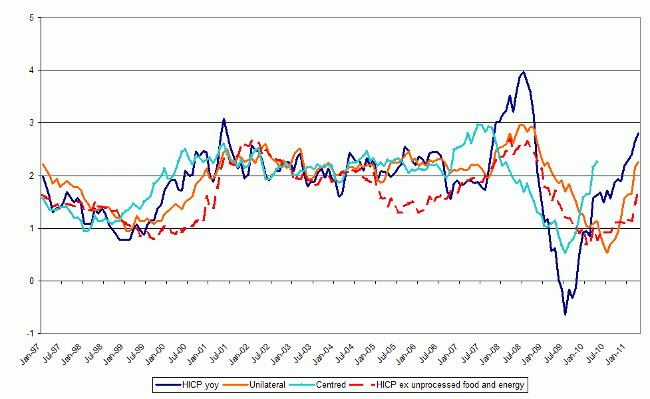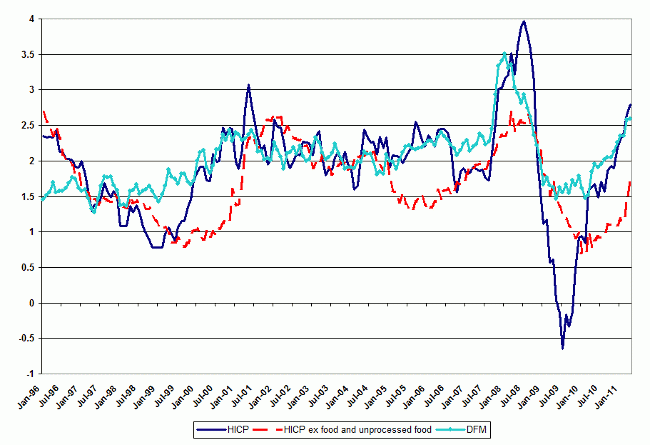In the last few weeks the press and several blogs have been engaged in a debate on the classic question of whether central banks should rely on headline inflation or core inflation (defined as headline inflation excluding energy and food) to obtain a signal for medium-term inflationary pressures. The debate, this time, was started by a Financial Times article by Lorenzo Bini Smaghi, board member of the ECB (Smaghi 2011).
Paul Krugman replied fiercely in The New York Times and put forward a defence for core inflation (Krugman 2011). Policy issues apart, in this column we would like to assess the two points of view.
Bini Smaghi’s argument is that core inflation is not a good predictor of medium-term inflationary pressure since, among other things, food and energy prices have a lasting impact on other items included in the aggregate measure of consumer prices.
Krugman replies that, since a central bank’s objective is to control medium-term inflation, one should not look at inflation over the past 3 months or 6 months but at inflation over the past three years.
Krugman reports some charts constructed using US data which show that “during the mid-2000s, 36-month headline inflation was strongly correlated with its own future while core failed to pick up the sustained rise in commodity prices – but this went into reverse when the commodity boom of 2007-2008 went bust”.
It is certainly true that a signal of medium-term inflation should be a smooth component of monthly or year-on-year headline inflation. The problem, however, is that, a measure of inflation over the past x year(s) is a lagging indicator of the inflation rate. What is needed is an index that is smooth, but also timely. In order to keep the timeliness but obtain smoothness, we could construct the centred moving average of monthly inflation, which is timely but volatile. Unfortunately this implies computing a linear combination of its past, present, and future values which is not feasible since the future observations are unavailable at the end of the sample. However, we might hope that core inflation is a good proxy for such a moving average. Does core inflation track a long moving average of monthly inflation without lagging it? This should be the way to reformulate Krugman’s observation. The question is entirely empirical.
Let us focus on Eurozone data. In the Eurozone the issue of which indicator of price pressures to look at is politically charged, since core inflation remains quite flat while headline inflation, defined here as the year-on-year growth of the Harmonized Index of Consumer Prices, is picking up.
Figure 1 below shows year-on-year headline inflation in the Harmonized Index of Consumer Prices (HICP) which, by construction, is a lagging indicator of month-to-month inflation, year-on-year core inflation (HICP excluding unprocessed food and energy prices), and two moving averages of headline. The centred two-year moving average of monthly headline inflation which, being a linear combination of past, present and future inflation, has one year of missing data at the end of the sample and a moving average constructed from the present and the past two years of observations (unilateral). The latter obviously lags headline inflation.
Figure 1. HICP, HICP excluding unprocessed food and energy, centred 2-year moving average, unilateral moving average
As expected, the centred moving average of monthly headline inflation is leading its yearly growth rate while the unilateral moving average is a lagging indicator of it. Core closely tracks the unilateral moving average apart from one episode. In no period, however, does it track well the centred moving average of yearly inflation nor its monthly version.
The same feature can be seen by looking at correlations. Below we report correlations between year-on-year headline and core inflation again for Eurozone data and for the sample 1996-2011. Specifically we consider correlations for different leads and lags.
Table 1. Correlations between HICP inflation (t+H) and core Inflation(t)
|
H=-12
|
H=-6
|
H=-3
|
H=0
|
H=3
|
H=6
|
H=12
|
|
.48
|
.70
|
.69
|
.61
|
.41
|
.20
|
-.17
|
Core inflation is more strongly correlated with the lags of headline inflation than with its leads and at the 12-month lead the correlation is negative. Clearly, on Eurozone data, core inflation is not a timely signal of inflationary developments.
One potential explanation of this fact is that energy and food inflation contain useful leading information on headline and it is a mistake to exclude them when constructing a predictor of medium-term inflation.
Research has indeed suggested that, in order to match long moving averages of monthly inflation, we should use many indicators, not only commodity and food prices but also surveys and financial variables. The idea is to use variables which lead monthly inflation as proxies for unavailable future information on inflation. The resulting index is a weighted average of leading, lagging and coincident indicators of monthly inflation. Averaging appropriately produces a smooth version of monthly inflation which is closely correlated with its one-year moving average but has no missing observations at the end of the sample.
In Cristadoro et al. (2005) such an index is proposed and constructed on Eurozone data and out-of-sample performance compared with those of core inflation and other indicators. Results confirm the heuristic discussion of this comment.
Figure 2 is based on updated results and reports the multivariate index, year-on-year inflation and core inflation. Results suggest that, six months from now, year-on-year headline inflation will be as high as year-on-year is today, in line with ECB forecasts for 2011. It is much harder to construct similar indicators for longer moving averages as it is impossible to obtain reliable forecasts at long horizons (for evidence on Eurozone data see Fischer et al. 2009).
Figure 2. HICP, HICP excluding food and energy, and multivariate index (DFM)
References
Bini Smaghi, L (2011), “Ignoring the core can keep inflation at bay”, Financial Times, 1 June.
Cristadoro, R, M Forni, L Reichlin, and G Veronese (2005), “A core inflation indicator for the euro area’’, Journal of Money, Credit and Banking, 37:539-560.
Fischer B, M Lenza, H Pill and L Reichlin (2009), "Monetary analysis and monetary policy in the euro area 1999-2006", Journal of International Money and Finance, 28(7):1138-1164.
Krugman, P (2011), “Core Madness”, The New York Times, 2 June.




